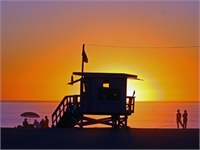
Enjoy a Swim in the Pacific… Yeah, Right
Important Notice: Our web hosting provider recently started charging us for additional visits, which was unexpected. In response, we're seeking donations. Depending on the situation, we may explore different monetization options for our Community and Expert Contributors. It's crucial to provide more returns for their expertise and offer more Expert Validated Answers or AI Validated Answers. Learn more about our hosting issue here.

Enjoy a Swim in the Pacific… Yeah, Right
You must be logged in to post a comment.
Most people who have never been to coastal Southern California have instead spent a lifetime convinced by media saturation that it is a place of warm sunshine all year long, that it hardly ever rains, that you can go to the beach in December to work on your tan and while there gawk at tall, tanned blondes in bikinis. This is true, of course, at least on a few days of the year. There are times when we see warm winter days that encourage sunbathers to lie on the sand, but they are rare. Nearly as rare are the warm summer days for which the Southern California is famous, at least if you go to the beach. On most summer days, the temperature along the coast barely breaks the 70 degree mark, and the marine layer—what most of us call overcast—can last all day. Sure, there are days when the sun breaks through and the temperature may rise to the mid- or even upper-70s, but they are a minority.
Of course, all bets are off when the Santa Ana winds blow. When the Devil Wind scours the Southland, the mercury can rise higher at the beach than it does out in the Mojave Desert. This is because the winds—which originate in the desert—force their way through many passes and canyons, and over hills and mountains on their way to the coast. The winds accelerate as they do this and resultant friction between the air molecules and the obstructing land raises the air temperature. When this happens, the temperature at the beach can reach the upper 90s and even break 100 at times. This is also when Southern California’s infamous "Fire Season" occurs (do you know of anyplace else on Earth that has a fire season? I didn’t think so.)
Unfortunately for heat-loving tourists, Santa Ana wind storms come but half a dozen times a year or so, and they rarely last more than a few days. Worse yet, most tourists come to LA in the summer, and though the Santa Anas do blow during summer, they are most common in early autumn, from September through early November. October is the hottest month on average in Los Angeles.
So suppose you’re a heat-seeking tourist and you happen to time your Southland visit perfectly, right in the middle of a Santa Ana event. The natural thing to do is head to the beach, spread out a towel, strip down to your swimsuit and dive into the water.
It may come as a surprise to newcomers the first time they plunge into the Pacific Ocean off Los Angeles and discover that the water temperature is in the mid-60s… if you’re lucky. That may not sound cold, but if you’re sweltering in 100 degree heat, it feels like dropping into ice water.
But don’t fret: the ocean water does warm up every year, usually sometime between late summer and mid-fall. Then it gets up to the upper 70s, which anyone would find comfy. Only there’s a nasty surprise waiting for you when the water gets that warm: it’s swarming with jellyfish. Yes, we have maybe two weeks a year of actual warm ocean water, and if you get into it you’re very likely to be stung, repeatedly.
What can you do? Tough it out. Jump into that brisk water, telling yourself, “It’s not that cold, it’s not that cold,” for the four or five minutes that you can bear it. Then, as you shiver on the beach rubbing your legs and arms to remove that annoying pale blue color, take note of the surfers and body surfers. Have you ever noticed that most wear partial or full wetsuits? Well, now you know why they do.